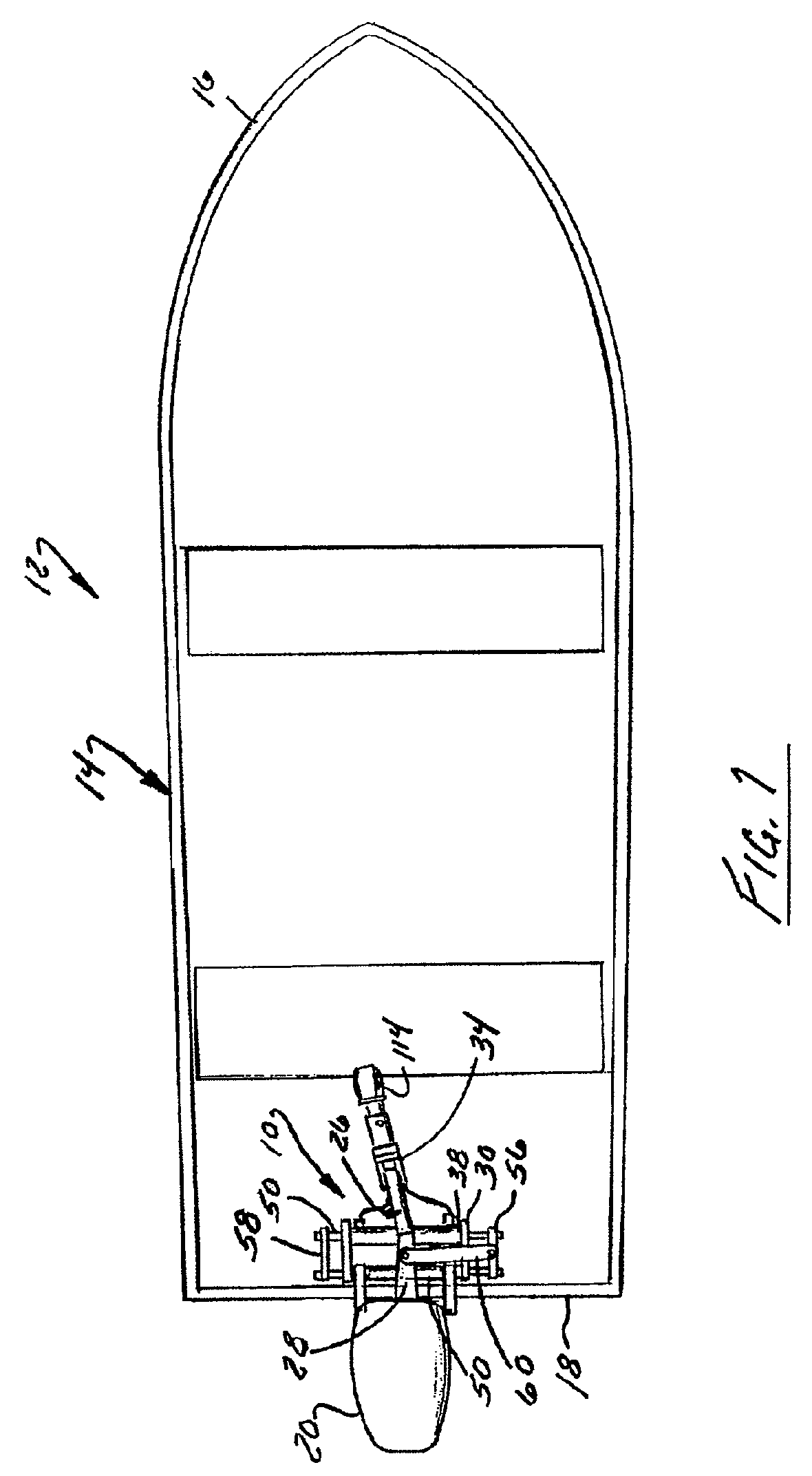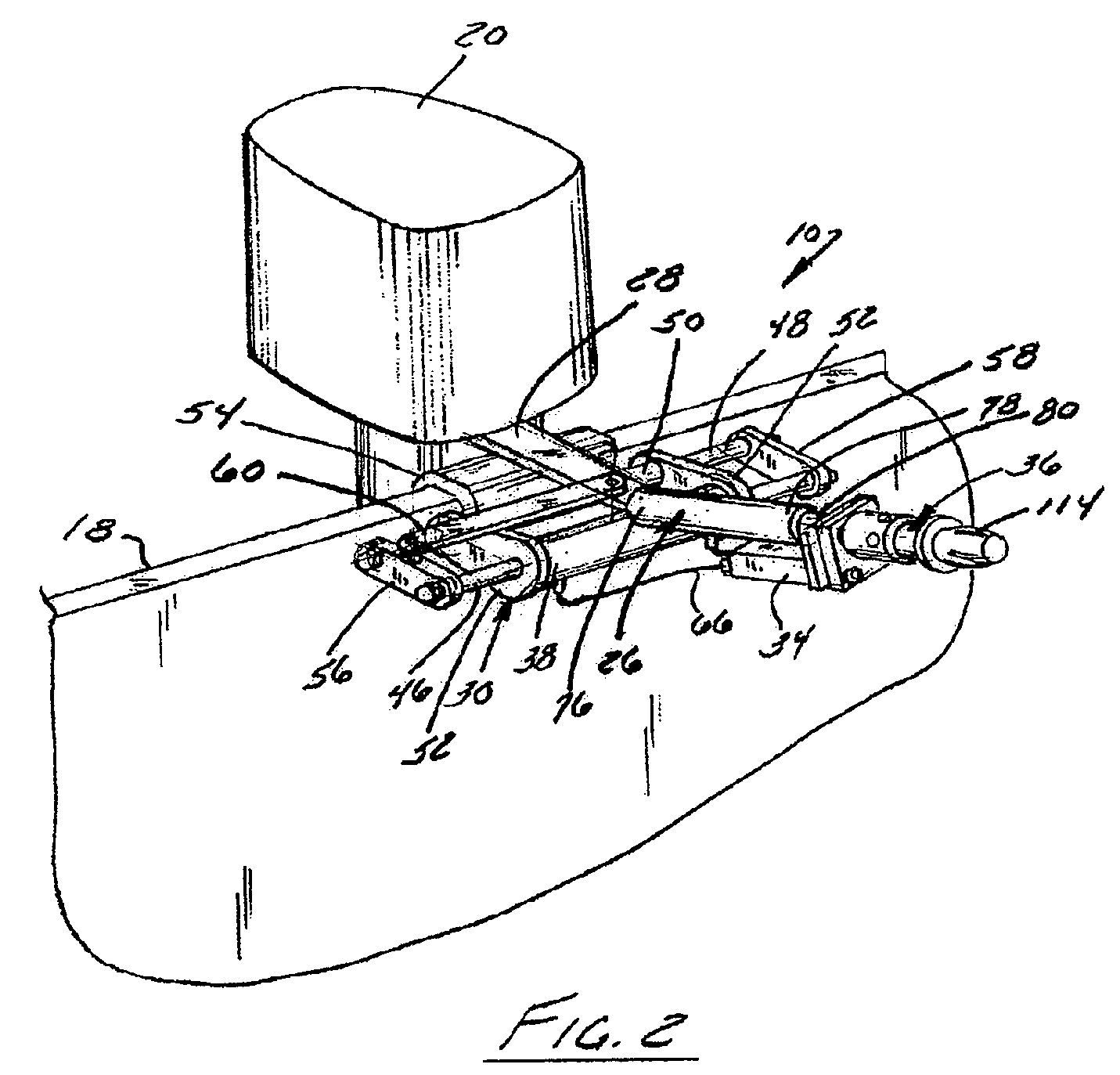Tiller operated marine steering system
a technology of marine steering and tiller, which is applied in marine propulsion, special-purpose vessels, vessel construction, etc., can solve the problems of operator fatigue, sharp curtailment of operator's freedom of movement, and change of steering angle, so as to relieve excessive hydraulic pressure and lessen seal drag condition
- Summary
- Abstract
- Description
- Claims
- Application Information
AI Technical Summary
Benefits of technology
Problems solved by technology
Method used
Image
Examples
first embodiment
2. Construction and Operation of First Embodiment
[0063]Turning now to FIGS. 2-7B and initially to FIGS. 2-4, a self-locking tiller actuated steering system 10 constructed in accordance with the first preferred embodiment of the invention include the above-described tiller, a hydraulic lock in the form of a cylinder assembly 30, and a valve assembly 32 that is housed in a valve unit 34 mounted on the underside of the tiller 26. The valve assembly 32 is responsive to tiller operation to selectively engage and disengage the hydraulic lock by selectively permitting or preventing a movable portion of the cylinder assembly 30 from moving. More specifically, the valve assembly 32 is actuated in response to movement of an actuator portion 36 of the tiller 26 relative to another portion of tiller from a neutral position thereof in order to permit fluid to flow to and from the hydraulic cylinder assembly 30 to disengage the lock and permit movement of the portion of the tiller 26 that is coup...
second embodiment
3. Construction and Operation of the Second Embodiment
[0079]Another embodiment of a self-locking steering system 210 constructed in accordance with the invention is illustrated in FIGS. 8-14. It is usable with the same boat 12 as shown in FIG. 1. It differs from the first embodiment primarily in that a more versatile valve assembly is used that is more easily incorporated into a standard tiller design and, in fact, can be retrofitted onto an existing tiller with little or no tiller modification. It is also illustrated as being used with a different cylinder assembly and steering linkage, but only for the purposes of illustrating the diversity of the invention. Components of the steering system of this embodiment corresponding to components of the first embodiment are designated by the same reference numerals in the drawings, incremented by 200. Hence, the steering system 210 includes a tiller 226, a steering arm 228, a steering cylinder assembly 230, and a valve assembly 232. The va...
third embodiment
4. Construction and Operation of Third Embodiment
[0096]Turning now to FIGS. 16-22B, a self-locking tiller actuated steering system 410 constructed in accordance with a third preferred embodiment of the invention is illustrated. The steering system 410 differs from those of the prior embodiments in that it is considerably simpler and less expensive to manufacture and assemble. It is also potentially more reliable. The most notable difference from a functional standpoint is that the control valves are actuated remotely by cables 490 and 492 rather than directly by the actuator on the tiller, hence permitting the valve assembly to be mounted on the cylinder assembly and providing a much simpler tiller extension.
[0097]Referring initially to FIGS. 16-18, the steering system 410 of this embodiment includes a tiller 426, a hydraulic lock in the form of a hydraulic cylinder assembly 430, and a valve assembly 432 that is housed in a valve unit 434 mounted on or even formed integrally with th...
PUM
 Login to View More
Login to View More Abstract
Description
Claims
Application Information
 Login to View More
Login to View More - R&D
- Intellectual Property
- Life Sciences
- Materials
- Tech Scout
- Unparalleled Data Quality
- Higher Quality Content
- 60% Fewer Hallucinations
Browse by: Latest US Patents, China's latest patents, Technical Efficacy Thesaurus, Application Domain, Technology Topic, Popular Technical Reports.
© 2025 PatSnap. All rights reserved.Legal|Privacy policy|Modern Slavery Act Transparency Statement|Sitemap|About US| Contact US: help@patsnap.com



